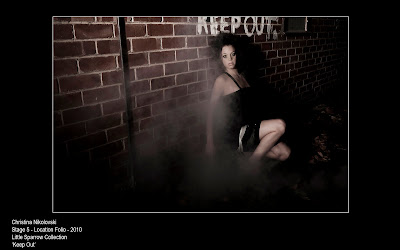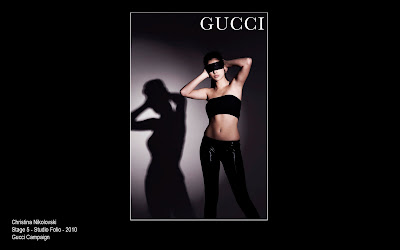Thursday, June 17, 2010
Thoughts
Tuesday, June 15, 2010
17/ What I Learnt this Semester
- Do not print at Bica
- Will print gloss at school next semester
- Some studio backgrounds (in both cases grey) printed with banding. To avoid this export these particular files as 16 bit tiffs as opposed to 8 bit jpegs
- My Workflow for Next semester: CR2s -> PSDs -> TIFFs for print, not JPEGs
- Off-cuts of matte board are cheap and perfect to mount on. Next time only buy white boards
- Bica prices: $22 per A3 (no corrections) | $60 per A2 | $15 per A4
- Bica paper is not pure white, and many prints were too dark and had a cast (i.e. red)
- Edit high res files as the shoots are completed, do not leave all the high res editing to the end
- Final Folders: SOURCE (CR2s + Xmp) | HIGH RES (Tiffs) | WEB (Jpegs) | SCREEN (Jpegs)
- What setting do I need to change on the power-packs so that the modeling light does not turn off every time after each flash is fired?
Monday, June 14, 2010
Publications






Sunday, June 13, 2010
16/ Defining my own style
Saturday, June 12, 2010
Final Portfolio Semester 1 2010
[1] Source: Newton, J Helmut by June, Canal Plus Byzance Productions, viewed 15 March 2010, < v="r9wkCLkVWcI">.

15/ Defining Style in Avedon's Work

I have been familiarising myself Avedon’s collection of work for a few weeks now in an effort to define his style. Avedon had a balanced collection of studio and location portraits. What is distinctive about Avedon’s collection of location work is it has a strong sense of narrative and emotion – fashion in Avedon’s photography is not just what I would call a ‘catalogue’ style – something was almost always happening – models are gambling, dancing, laughing, smoking, talking. Promoting fashion as a glamorous lifestyle was evident in Avedon’s work. Parallels can be drawn between Avedon’s work and the work of Helmut Newton in terms of narrative, although Avedon’s work contained much less nudity. Both photographers had a playful and cinematic approach to fashion photography.
Avedon’s style has developed since 1944. His collection of work in the 1940s was mainly location work, in which he photographed staged scenarios such as a female sitting at a restaurant table by herself ‘waiting’ for a call. Overall in this decade, the female figure was depicted as a happy strong woman. The cigarette is was a repeated symbol of strength and defiance and perhaps glamour. Men and women in photographs during this era were seemingly equal and content with their status in society.

Richard Avedon | Dorian Leigh with cyclist, 1949
As we move to the 1950s, studio photography became much more prevalent in Avedon’s work. There was still an element of playfulness, but a serious and superior element was now also apparent in Avedon’s work. Backlighting became more common in Avedon's work, featured mainly in his location photographs where the models are at an outing. Ambient light was now used in combination with artificial stage lights to achieve the effect of backlighting.
Richard Avedon |Suzy Parker, evening dress by Dior, Paris, 1956
Richard Avedon lights his subjects in a sunlit studio
Richard Avedon | Suzy Parker with Robin Tatersall 1956
Parker is backlit with what appears to be artificial light and front lit by ambient light or artificial light.
Richard Avedon | Suzy Parker with Robin Tatersall 1957
Whereas the 1940s predominantly featured a playful fun side of fashion photography, the work that Avedon produced in the 1960s was a balance of both playful and serious fashion photography. Nudity was introduced and studio fashion photography was further explored. Strong feminine lines were dominant in this body of work, emphasised by long tight dresses and a contrast of lighting and the background. Flash photography was now evident in Avedon’s work that can be seen in the catch lights of the model’s eyes in the studio, and the balance of dusk and the models in Avedon’s image of Jean Shimpton and Jeanlop Sieff.
Richard Avedon | Jean Shimpton and Jeanlop Sieff, 1966
In the 1970s a major development in technology became evident in Avedon’s work; colour. Avedon’s work was still predominantly shot in black and white, but colour transparencies were now also used. Avedon explored androgyny in his photography, which was particularly evident in his portraits of Veruschka in 1973, a female model who was photographed with a man’s shirt but with her breast’s showing and what arppeared to be a drawn on moustache and thickened eyebrows and short hair. Veruschka was also photographed in a man’s suit and tie with a top hat. With this new element evident in Avedon’s work he challenged the idea of ‘conventional’ fashion photography and the ‘typical’ female in society. Technically, Avedon’s photographs appeared sharper and less grainy, most probably due to an introduction of flash photography and perhaps digital photography.

Richard Avedon | Veruschka, New York 1973
Richard Avedon | Veruschka, New York 1973
 Richard Avedon | Aurore Clement 1974
Richard Avedon | Aurore Clement 1974
 Richard Avedon | Janice Dickinson 1977
Richard Avedon | Janice Dickinson 1977
In the 1980s almost everything Avedon produced was in colour. Avedon began photographing groups of models and creating connections between them and interesting compositions. Avedon also made reference to religious paintings, this is evident in his Versace advertising campaign in the fall of winter of 1981-1982. Avedon also portrayed a suggested exploration of sexuality, which was also evident in the Winter Versace Campaign of 1981, where a heterosexual couple were photographed next to what appeared to be a lesbian couple.
Richard Avedon | Versace Advertising Campaign 1981
In the 1990s Avedon produced photographs that were a balance of colour and black and white photography. It also appeared that some of his black and white work was shot on medium format film, showing that Avedon still had an appreciation or desire to use film when digital photography was now the norm. Multiple flash lights were used create more dramatic light in the studio, shown by the catch lights in the model’s eyes and the high ratio’s employed. Movement was again a dominant feature of Avedon’s style, now even sharper due to superior technology. Nudity and couple shots were common in this decade. Props were also more prevalent in Avedon’s studio shots, and these included sand, leaves, silk material, skeletons, toys, cigarettes and money. Flash was also used on location and backlighting was once again dominant in Avedon’s series titled ‘In Memory of the Late Mr. and Mrs. Comfort’. Composites were now a part of Avedon’s work, also evident in this series.
Richard Avedon, In Memory of the Late Mr. and Mrs. Comfort, 1995
The more I look at Avedon’s work the more I realise how amazing he actually was. Since the 1940s when all that was available to a photographer was a basic film camera and no flash, Avedon created believable and interesting scenarios that employed an element of narrative to fashion photography. Every photograph featured in Avedon’s ‘Definitive Collection’ book has an element of interest; nothing is what I would term ‘stock’ photography.
In Avedon’s biography he mentioned that when he began studying photography at the Pennsylvania Museum of Industrial art he looked up to and was influenced by his teacher, Alexey Brodovich who was also the art director. He mentioned that he [Brodovich] ‘was very much like my [his] father’ (Avedon, 1933) [1] Brodovich’s theory was that ‘visual education was very dangerous and likely to develop certain clichés’[1], so he pushed his students to take a ‘unique’ stance with their photography. Students knew not to submit a photograph unless it had a new concept or unique or interesting suggestion.[2] Perhaps it was Brodovich who initially inspired Avedon to create these amazing masterpieces and strive to produce that ‘wow’ factor in his work since the 1940s. It appears that technology only helped Avedon capture what he visualised, he was a visual master all along.
Richard Avedon | Veruschka, New York 1967
[1] Squiers, C & Alletti, V 2009 Avedon fashion 1944-2000, Abrams, New York, p. 156.
[2] Squiers, C & Alletti, V 2009 Avedon fashion 1944-2000, Abrams, New York, p. 158.
Bibliography
Bellis, M 2010 Photography timeline, The New York Times company, viewed 10 June 2010, [http://inventors.about.com/od/pstartinventions/a/Photography.html].
Roth, P 2010 The Richard Avedon foundation, Avedon Foundation, viewed 10 June 2010 [http://www.richardavedon.com/#p=-1&a=-1&at=-1&mi=1&pt=0&pi=2].
Squiers, C & Alletti, V 2009 Avedon fashion 1944-2000, Abrams, New York.







































